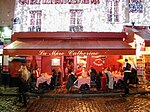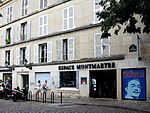Place Jean-Marais
Buildings and structures in the 18th arrondissement of ParisSquares in Paris

The Place Jean-Marais is a square in Paris' 18th arrondissement of Paris, in the front of Saint-Pierre de Montmartre Church, not afar from the Place du Tertre, on the top of Montmartre. It was named for the famous actor Jean Marais on 26 April 2008. It was inaugurated in the presence of Daniel Vaillant, mayor of the 18th arrondissement of Paris, Christophe Caresche, and Michou.
Excerpt from the Wikipedia article Place Jean-Marais (License: CC BY-SA 3.0, Authors, Images).Place Jean-Marais
Place Jean Marais, Paris Quartier de Clignancourt (Paris)
Geographical coordinates (GPS) Address Nearby Places Show on map
Geographical coordinates (GPS)
| Latitude | Longitude |
|---|---|
| N 48.886666666667 ° | E 2.3413888888889 ° |
Address
Salles paroissiales
Place Jean Marais
75018 Paris, Quartier de Clignancourt (Paris)
Ile-de-France, France
Open on Google Maps











